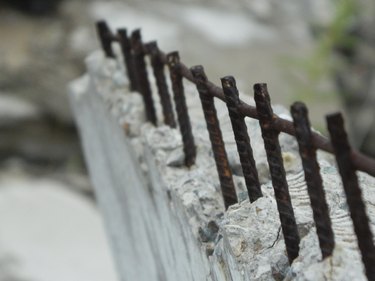
Rebar is a common trade name for steel reinforcing bar. The product is used to add strength and other qualities to poured concrete structures, such as columns, walls and foundations. As with steel used in other industries, rebar is manufactured in different sizes and grades. Based on its grade, some rebar used in construction can be welded, while some cannot.
Weldable Rebar
Video of the Day
According to The American Welding Society publication "AWS D 1.4," low-alloy steel rebar can be welded. The steel-to-carbon ratio of this grade of steel is suitable for welding, and the welds can be expected to hold together under load and after they are sealed in concrete. This is the only rebar ready to weld without special consideration given for a particular use and application. W grade, low-alloy steel, specifically A706 steel, can be welded when used in steel fabrication.
Video of the Day
Non-weldable Rebar
The formula of steel is the determining factor for whether or not steel can be welded. Steel with high carbon content, such as high-strength alloy steels, is relatively brittle. The more brittle the steel, the more likely a weld will fracture under stress. Imagine trying to bend a piece of soft taffy candy as opposed to bending taffy just out of the freezer. The soft material bends, while the brittle material fractures. High-strength and alloy steels may not be welded because they're more likely to fracture under load.
How Rebar Adds Strength
As poured concrete hardens around rebar or rebar structures, the aggregate (stone or gravel) in the concrete is locked into place around the ribs of the rebar, forming a mechanical bond. Concrete has high compressive strength (resistance to pressing forces) but poor tensile strength (resistance to bending or stretching forces). Steel adds tensile strength to concrete structures, allowing the brittle material to be used for horizontal members, such as bridge beams.
Non-welded Connections
When rebar cannot be welded the pieces are mechanically tied together with 16-gauge wire. The advantage of wire-tied rebar is that complex cages and other structures can be built on the construction site. Once the concrete is poured and has cured around the rebar, the solid mass of concrete locks the joints together. On the job site, tying rebar together is be much quicker than individually welding each joint.